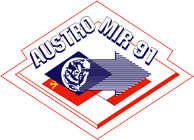The brain’s performance is affected by many factors during a stay in space: some of these being microgravity and its effects on the body, the changes of the sleep-awake-rhythm and through stress resulting from intense work. It results in higher brain activity. Examples are the coordination between visual perception and movement, spacial perception and processing, speech, memory and an amount of brain control functions.
An experiment with a healthy subject deals with the various cognitive processing mechanisms in both hemispheres of the brain. A study on patients with chronic brain injuries after a borreliosis sickness was carried out, and a medicinal study should gather information on the influence of shift work on cognitive functions. An application of the developed software is already being tested in neuropharmalogical and therapeutical areas, especially in the rehabilitation of patients with brain damage.
Objectives
The experiment’s target is to find out how these factors influence the so-called cognitive functions. COGIMIR analyzes the cognitive performance of the Austrian scientist-cosmonaut before the space flight, during his stay on the space station and after his return to earth.
Functionality, Measuring principle
During his stay on MIR, the cosmonaut had to perform a total of seven tests in three separate procedures. The tasks were given by the onboard computer in the form of visual stimuli and the cosmonaut gave his answer by pressing a key on the keyboard. An example: A three centimeter long straight line was displayed for hundred milliseconds on the monitor. The next picture showed a straight rosette made up of nineteen straight lines marked by letters. The cosmonaut had to type in “his” lines and letters. As with all other tests, the reaction exactness (percentage of correct answers and the reaction time) was registered. The cosmonaut’s reaction ability with and without choice selection, the reproduction of time spans, attentiveness and operative memory as well as the two-dimensional spacial thinking and spacial memory were assessed. In order to avoid the learning effect after multiple instances of the tests, the tasks were given randomly and in alternative forms.
Shared equipments of the Austrian payload
DATAMIR
Results
Data analysis showed no noticeable changes in the cosmonaut’s memory abilities. The observed ability fluctuations could be the result of functional reorientation combined with the adaptation to microgravity.
One should notice that the visual-spacial processing functions remained unchanged during the stay on MIR and after the flight. The good cognitive performance of the cosmonaut was the result of multiple factors: the long learning and training phase, the good working conditions on the space station, his high motivation and the good status of the body during the flight.
In general, the scientific targets of the experiment were met. The various phases of the investigation – before and during the flight and in the regeneration phase afterwards – the data won enabled a reliable assessment of the cosmonaut’s cognitive status. The scientific principles on the updated assessment of higher physical functions, the methodology and the software for the execution of the investigation and the analysis of the results have thus been proved. They have proved that one can win the required objective information with their help. This is not only important for the practice of medical treatment during long flights, but also for a whole range of medical fields back on earth. Crucial for the practical application are the significance of the developed methodologies, the simpleness of the implementation and the automatization level.
Practical application
Application ranges
- Psycho physiology
- Klinical neurology
- Occupational medicine
- Experimental psychology
Application target
- Checkup of the function of either hemispheres
- Medical state checkup of cosmonauts
- Study of the state of the patients psychological functions with brain diseases
- Appraisal of the effectiveness of the neuropharmacological and further therapeutical interventions
- Appraisal of the influence of the vocation and shift work on the cognitive functions of human
- Therapy methods for patients with cerebral damages
Direct interested institutions on the utilization of the experiment results
- University Clinic for Neurology, Innsbruck
- Institute for Biomedical Problems, Moscow
Technical characteristics
The at COGIMIR used test software included the following programs, which were installed on the central computer DATAMIR, on which the experiment was taken out, too:
- Assessment with a simple reaction (SREACT)
- Assessment of an alternative sensomotorical reaktion (CREACT)
- Reproduction and memorisation of time intervalls (TIMEST)
- Assessment of the attention and the operative memory (ARROWS)
- Two tasks to assesse the two-dimesional visual-spatial thinking and percipience (LINE 1 und LINE 2)
- Specification of the spatial memory (SPATLO)
Experimenters
o. Univ.-Prof. Dr. Franz Gerstenbrand (institute manager)
Univ.-Doz. Dr. Thomas Benke (project manager)
all: University Clinic for Neurology, Innsbruck
